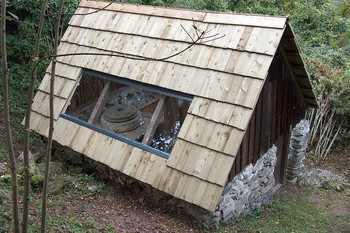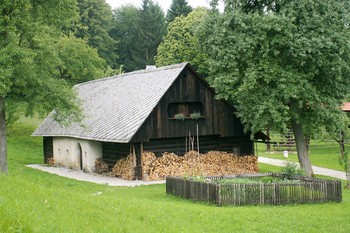Open-Air Museum
One of Slovenia's first open-air museums was set up in 1962 by the Škofja Loka Museum in cooperation with the Škofja Loka Museum Society. The old Škopar House from the village of Puštal and nine other buildings/facilities were transferred to the castle garden. Of these building, the Škopar House, as well as a hayrack and a mill are still on view today.
For curious minds:
- According to Dr Ivan Sedej, the Škopar House dates back to the 16th century. In terms of the house type, it is a house with a smoke kitchen, presenting the dwelling culture of owners-occupiers and small farmers from a wider Škofja Loka area in the period between the 16th and the late 19th centuries. The age of the house is at least partly indicated by the windows in the main living area, which are fitted between two beams and are closed by means of a mechanism called "zapahnice" ("bolts"), as well as a stone entrance portal with chamfered edges ending in the shape of "a buckwheat grain" above the threshold.
- Like most other people in the village of Puštal, the owners of the Škopar House owed their allegiance to the Puštal Manor. According to folk tradition, a distant ancestor used to work for the lord of the Puštal Manor as a straw-cutter – "škopar" in local parlance – hence the house’s name "at the škopar's". Eight generations ago, a tailoring business was housed in the building. The very last tailor to work from the house was Franc Eržen, born in 1908, who had a workshop in the main living room.
- The hayrack was used for drying hay, grain stalks bundled and bound into sheaves, clover, beans, etc. The earliest hayracks date back to the 16th and 17th centuries, when a new crop, i.e. buckwheat, was starting to be introduced. Buckwheat was sown in the fields immediately after the harvest of other cereal crops. Therefore, other cereal crops could no longer be left in the field to dry and the newly-built hayracks were used for this.
- The little stone house on the slope of the castle garden features a trade mill with a grinder and stamps, as well as the cereal crops that were grown in the Škofja Loka area back in the day. The first mention of the mill in area dates back to 973, when the mill was mentioned in a deed of gift. The earliest mills, listed in the 1291 rent roll, stood by the river Selška Sora and were owned by the lord of manor.


